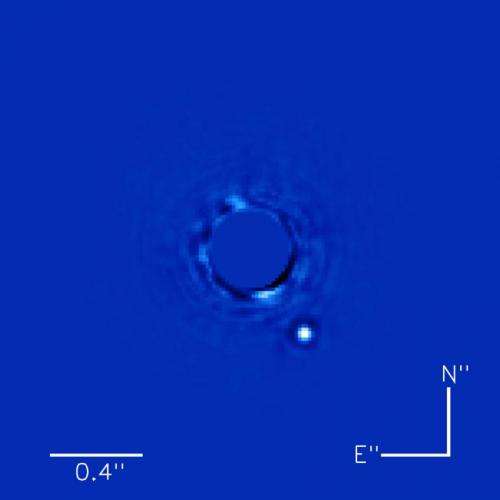May 13, 2014 report
Gemini Planet Imager captures best photo ever of an exoplanet

(Phys.org) —A team of researchers at the Gemini South telescope in Chile, which has recently been retrofitted with the Gemini Planet Imager (GPI) is reporting in Proceedings of the National Academy of Sciences, that they have captured the best photo ever of an exoplanet orbiting its star. The planet, Beta Pictoris b, orbits its sun approximately 63.5 light years from us, and the GPI has allowed for calculating its orbit at 20.5 years.
Taking pictures of exoplanets is difficult, not only because they are so far away, but also because of Earth's atmosphere and of course because they are near to a star that is much brighter, which tends to overcome the light reflected off its planets. The engineers who designed the GPI used multiple techniques (a field spectrograph that has both low spectral resolution and high spatial resolution and a coronagraph that suppresses diffraction) to mask direct starlight, while simultaneously enhancing the light that is bounced off of nearby planets. The result, the team reports is an instrument capable of producing images of exoplanets that are an order of magnitude higher than any other previous imaging systems.
Beta Pictoris b is a gas giant similar in size to Jupiter, though its star is much younger than ours—just 12 million years old. The picture of it was created with an exposure of just one minute, which is a record for an image of an exoplanet—the planet orbits its star just a little closer than does Saturn in our solar system. It was first discovered in 2006 by researchers working with data from the Hubble Space Telescope and verified three years later by researchers at Europe's VLT. Pictures taken at the time suggested that Beta Pictoris b had to regularly plow through space debris of some sort, causing it to appear murky at times.
Beta Pictoris b was chosen as a first test run due to its designation as an easy target. The research team at Gemini South plan to move on to imaging other exoplanets, eventually taking pictures of at least 600 that appear promising. Doing so will help with better understanding orbit times and perhaps help with refining their ages and masses.
More information: First light of the Gemini Planet Imager, Bruce Macintosh, PNAS, DOI: 10.1073/pnas.1304215111
Abstract
The Gemini Planet Imager is a dedicated facility for directly imaging and spectroscopically characterizing extrasolar planets. It combines a very high-order adaptive optics system, a diffraction-suppressing coronagraph, and an integral field spectrograph with low spectral resolution but high spatial resolution. Every aspect of the Gemini Planet Imager has been tuned for maximum sensitivity to faint planets near bright stars. During first-light observations, we achieved an estimated H band Strehl ratio of 0.89 and a 5-σ contrast of 106 at 0.75 arcseconds and 105 at 0.35 arcseconds. Observations of Beta Pictoris clearly detect the planet, Beta Pictoris b, in a single 60-s exposure with minimal postprocessing. Beta Pictoris b is observed at a separation of 434 ± 6 milliarcseconds (mas) and position angle 211.8 ± 0.5°. Fitting the Keplerian orbit of Beta Pic b using the new position together with previous astrometry gives a factor of 3 improvement in most parameters over previous solutions. The planet orbits at a semimajor axis of 9.0+0.8−0.4 AU near the 3:2 resonance with the previously known 6-AU asteroidal belt and is aligned with the inner warped disk. The observations give a 4% probability of a transit of the planet in late 2017.
Journal information: Proceedings of the National Academy of Sciences
© 2014 Phys.org




















